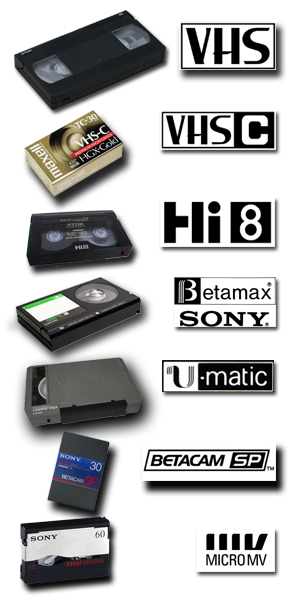We cater for all domestic and most commercial tape formats
Main video formats
VHS and VHS-C tapes
Perhaps the most common video format. Smaller VHS-C were used in domestic cameras and required a caddy to play them back in a regular video player.
Hi8, Video8 and Digital8
Smaller tape format than VHS-C used in domestic cameras and generally produced a clearer sharper image than VHS-C. These tapes could only be played back in the camera or a dedicated desktop player. There was no caddy system similar to the VHS-C system.
Betamax
This format was in direct competition with VHS and produced a slightly better recording, however it never quite achieved the popularity of VHS.
miniDV and DV-CAM
This format used a 1/4" tape and tiny cassette suitable for use in smaller cameras. This format became obsolete when solid state memory chips came down in price. Many miniDV cameras are still used today.
U-Matic
An early commercial video format with excellent playback quality. Some tape formulations became problematic with a condition known as oxide shedding. The coating that holds the video information would wipe off the tape, clogging playback heads with resulting drop in playback quality.
BetacamSP
This format was another early analogue broadcast format use extensively in the TV industry, producing excellent image quality. It did not suffer from the same problems associated with U-Matic tapes.
A bit about video tape...
Many different video formats emerged following the demise of 8mm and 16mm film. Unfortunately the formulation used on magnetic tape also has a limited lifespan. Tapes can degrade in as little as 12 to 15 years.
DVD is considered to be old technology now so tapes are digitised to MP4. This format can be played on most modern TVs that have a USB port and all computers, iPads, tablets and phones. It is the most widely used video format .
The moist Australian climate can cause mould to grow inside the tape housing and on the edge of the tape. It is important not to play tapes in this condition as this will clog and possibly damage playback heads in your machine. We can clean VHS and VHS-C tapes to remove this contamination prior to transferring.
Hi8 tapes are prone to tearing when the mould bonds to the layer below it. This can sometimes be fixed but requires the tape to be removed from the case to dissolve the mould spores in a special solution.
We have the equipment to convert the following formats.
